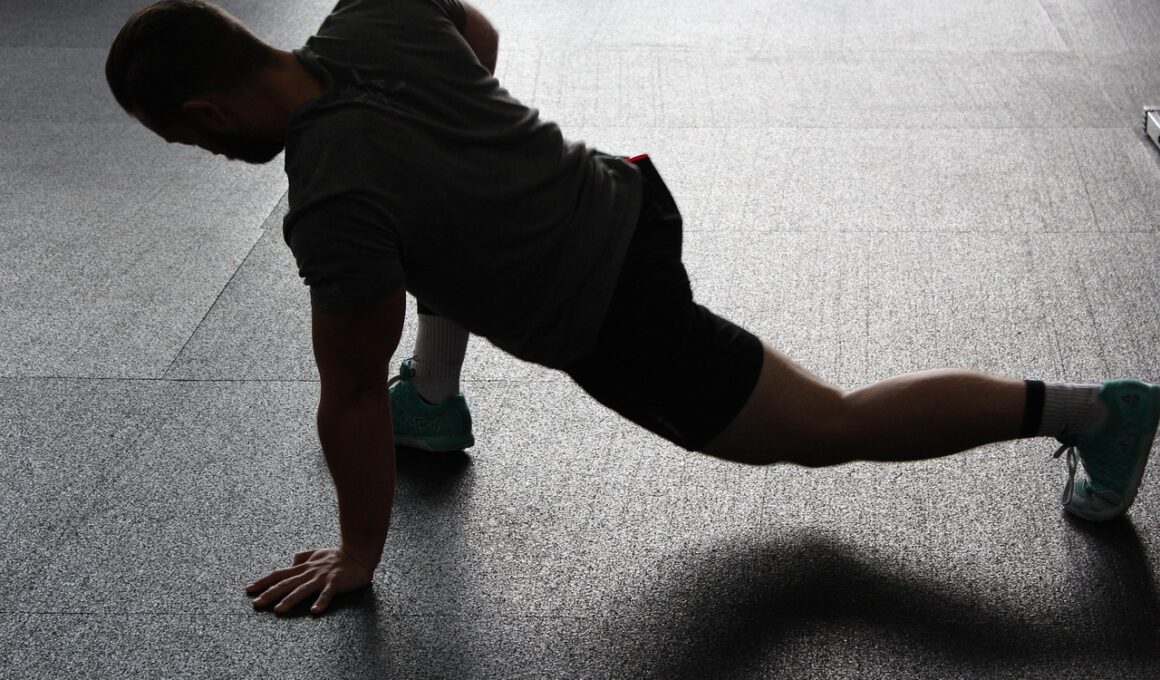Effective Warm-Up and Cool-Down Routines for Bike Training
Before diving into your bike training sessions, it’s crucial to implement proper warm-up routines to enhance performance and reduce injury risk. Start with a gentle five to ten-minute ride at low intensity, allowing your muscles to gradually adjust. This can be followed by dynamic stretching exercises, targeting key muscle groups used in cycling. Include leg swings, gentle lunges, and arm circles to engage your entire body. Accentuate your warm-up with specific cycling movements, such as spinning the pedals without resistance to stimulate blood flow. Another excellent approach is to incorporate drills that mimic racing conditions, which boosts your mental readiness and helps your body acclimate to upcoming stresses. Always remember to stay hydrated and focus on your breathing throughout each activity. Pay attention to how your body feels during the warm-up, adjusting as necessary to ensure a comfortable start. Having the appropriate gear, like a properly fitted bike, also contributes to an efficient warm-up routine. By dedicating time to warm-ups, cyclists can experience improved performance and enjoy longer, more successful rides. Discover more strategies by following reputable cycling training resources.
Transitioning to the cool-down phase post-ride is equally important for overall recovery and muscle health. Aim for a similar duration of around five to ten minutes in your cool-down as enjoyed during the warm-up. Begin by reducing your cycling intensity progressively, allowing your heart rate to return to its resting levels. Following the reduction in intensity, incorporate static stretching to alleviate tightness in your muscles and promote flexibility. Focus on the major muscle groups like quadriceps, hamstrings, calves, and hip flexors during these stretches. Holding each stretch for 20 to 30 seconds will enhance the cooling process. Additionally, include upper body stretches to counterbalance muscle tension, which often arises from prolonged cycling positions. Post-ride hydration should not be overlooked to help expedite recovery, as well as to replenish lost fluids. Nutritional considerations are also valuable; consuming a recovery meal or snack rich in carbohydrates and protein will aid in muscle repair. Establishing a well-structured cool-down routine is a necessary habit for serious cyclists, as it not only improves performance but also reduces the risk of injury. Building on proper warm-ups and cool-downs creates a sustainable training regimen.
Incorporating Flexibility Training
While focusing on warm-ups and cool-downs, integrating flexibility training into your overall bike training plan can lead to enormous benefits. Improved flexibility enhances your performance on the bike and helps prevent injuries. Adding regular flexibility exercises, such as yoga or Pilates, can significantly improve your range of motion. These activities emphasize critical muscle groups while also promoting relaxation after a workout. Practicing yoga allows cyclists to loosen up, increase balance, and foster mental clarity, all of which are advantageous for competing in triathlons. Aim for at least one session a week tailored specifically to enhance leg and core flexibility, as they are essential components of effective cycling performance. Incorporating foam rolling after rides further complements recovery, aiding in breaking down muscle knots caused by strenuous activities. Remember to listen to your body – every individual has a unique flexibility level and tolerance. Avoid forcing stretches; focus instead on gradual progress. Use resources like online instructional videos or local classes to engage with flexibility training comfortably. Set concrete goals for your flexibility journey, and celebrate each milestone to maintain a positive outlook. Consistency is key in reaping the rewards of flexibility training.
Having discussed warm-ups and cool-downs, it’s critical to understand how mental preparation plays a role in effective bike training. Mental readiness enhances focus during workouts, which is key for achieving your cycling goals. Set clear intentions before each training session, providing a motivation anchor that keeps you on track. Visualize yourself successfully completing your rides or races to cultivate a positive mindset. This mental exercise aids in developing resilience, which is particularly beneficial for enduring the challenges of biking. Additionally, integrating mindfulness and breathing exercises into your training can improve concentration and lessen anxiety. Focus on your breathing pattern while riding; it has a direct impact on your body’s performance. Experiment with techniques that resonate with you, like counting breaths or incorporating rhythmic breathing that matches your pedaling. Keeping a journal can aid in tracking both performance outcomes and mental states during biking sessions. Reviewing your progress formulates a deeper connection to your practice while highlighting areas for improvement. Consequently, a well-rounded approach that includes mental training, alongside physical warm-ups and cool-downs, will provide comprehensive benefits to your triathlon preparation and biking experience.
Understanding the Importance of Recovery
Recovery is a pivotal part of any effective bike training regimen, influencing overall performance during subsequent rides. Acknowledging the body’s need for recuperation can significantly enhance endurance and strength. It’s essential to incorporate designated rest days within your training schedule to allow for muscle repair and adaptation. During active recovery days, consider participating in low-intensity activities such as walking, swimming, or gentle yoga, enabling continued movement without straining your muscles excessively. Prioritize hydration and nutrition, ensuring adequate protein and carbohydrates support muscle recovery. Interestingly, sleep quality plays a crucial role in recovery; aim for sufficient nighttime rest to optimize performance. Restorative techniques like cold therapy, massages, or foam rolling can help to alleviate soreness and enhance recovery. Regularly scheduled recovery weeks, where you reduce training intensity and volume, allow your body to adapt to the growing training load. Listen to your body’s cues to prevent overtraining, which can lead to injury and burnout. Balancing training and recovery will ultimately lead to enhanced cycling performance, ensuring you feel rejuvenated and prepared for each ride. An effective recovery strategy allows for sustainable progress within any bike training program.
In addition to physical recovery, proper mental recuperation is equally important. After intense bike training sessions, it’s important to give yourself time to mentally recharge. Engaging in enjoyable activities that divert your focus away from cycling, such as reading or spending time with loved ones, fosters mental wellbeing. Allow yourself to disconnect from training targets every once in a while, as this can prevent burnout and keep your passion for biking alive. Meditative practices can also be integrated, guiding your thoughts back to the present moment and reducing stress levels accumulated through intense training. Mindfulness involves tuning in to your body, assessing how you feel after rides, and ensuring you’re emotionally in check. This approach nourishes the connection between your body and mind, culminating in a more holistic training experience. Furthermore, setting realistic goals can help you maintain motivation while also enjoying the journey. Celebrate small achievements as you progress towards larger targets; these victories serve as integral milestones on your cycling path. Ultimately, prioritizing mental recharge helps create a sustainable biking practice that nurtures your commitment and fosters long-term enjoyment.
Engaging with Community and Resources
Lastly, engaging with the cycling community and leveraging available resources can greatly benefit both training and recovery. Seek forums and clubs in your area to foster friendships and facilitate shared experiences with fellow cyclists. These connections can yield valuable insights into effective training and recovery strategies. Online platforms, such as social media groups or websites dedicated to cycling, also provide a wealth of information on bike training. Consider attending workshops or group rides that cover specialized topics, which can help expand your skillset. Additionally, accessing professional coaching can provide individualized guidance tailored to your unique cycling aspirations. Reading books and articles, or watching instructional videos, further enhances your understanding of effective training techniques. As you progress, sharing your own experiences with others can create positive interactions and motivate both you and your peers. Engaging in discussions with seasoned cyclists can uncover new tips, leading you to discover additional strategies for optimal warm-ups, cool-downs, and recovery. Stay committed to lifelong learning in cycling, which enriches your training approach and adds value to your journey.
Ultimately, implementing effective warm-up and cool-down routines is crucial for every cyclist looking to improve their performance. The emphasis on gradual transitions in intensity before and after workouts makes significant differences in achieving goals while reducing injury risk. Flexibility training, mental preparation, and recovery all connect intricately, enhancing not only physical performance but also overall enjoyment of the sport. Engaging consistently with community resources fosters an environment of growth and motivation, propelling you forward in your cycling journey. Care for both your body and mind leads you to uncharted territories in your competitive aspirations, enabling a sustainable approach that lasts through seasons. Understanding these fundamentals can elevate your capabilities and transform each training day into a valuable experience. Thus, prioritizing these aspects will ultimately cultivate confidence and resilience. For those embarking on this path, take note of how these practices strengthen your foundation, ensuring your commitment to cycling remains steadfast over time. Encouragement often breeds an uplifting atmosphere; surround yourself with like-minded individuals and peer support to facilitate progress. With passion, dedication, and the right knowledge, you can conquer any cycling challenge that arises!


